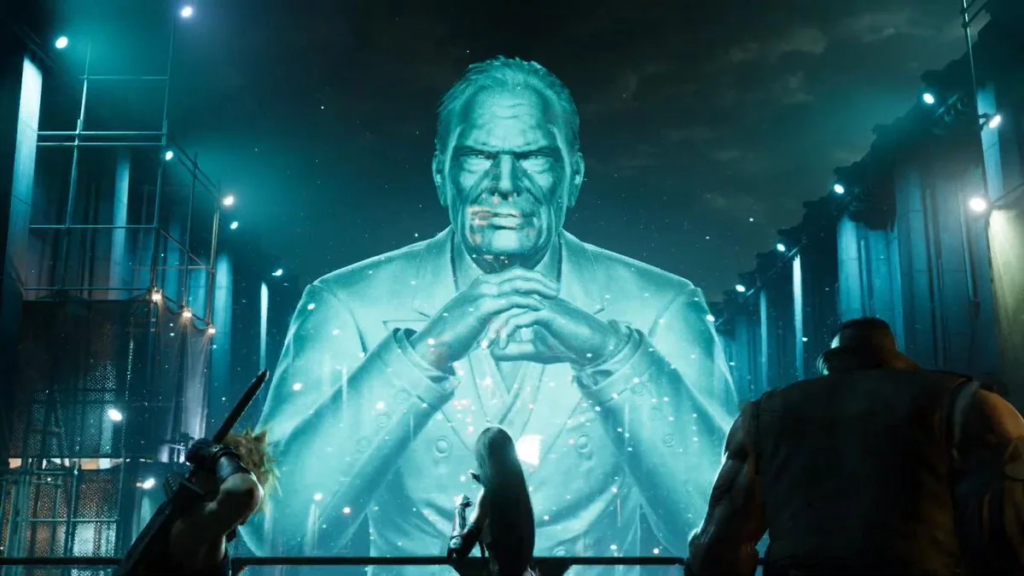Someone watching the recent Silent Hill announcement livestream would see live comments mockingly suggesting that Silent Hill NFTs were going to be announced. It’s not a surprise considering that Konami, the Japanese company that owns the Silent Hill IP, has a history of favoring new, unpopular business trends at the expense of hurting the value of its highly sought-after IP.
And it’s not only the people playing games that relentlessly attack NFTs. Major video game media outlets have a regular practice of dunking on NFTs. When major publisher Square Enix discussed its plans for NFTs, Kotaku gleefully posted its article alongside a picture of Final Fantasy VII’s evil CEO antagonist. Read any coverage of NFTs by Kotaku, and you’ll see paragraphs of citations pointing to the abject failures of NFTs as a business practice in gaming.
Both strong consumer and media pushback have led to video game companies being forced to answer for their NFTs business decisions, if not walking them back altogether. Ubisoft, the developer responsible for, inter alia, Assassin’s Creed, Far Cry, and Just Dance, had to delist their initial NFT announcement video and issue a response regarding NFTs. Square Enix decided to tie its NFTs to a physical statute.
It should be noted that companies are not quite done with NFTs. Square Enix has persisted in the NFT space as per its New Year’s letter and Gabe Newell, the co-founder of Valve, focused his criticism instead on bad actors in the space.
Still, plenty of game developers and publishers have distanced themselves from NFTs. Minecraft developer Mojang banned them. Steam, the preeminent PC gaming marketplace, also bans web3-related games. Blizzard, the developer of World of Warcraft and Overwatch, had to swear that they weren’t doing NFTs after a fan scare. PlayStation, in announcing a recent program that would award digital prizes, emphasized multiple times that NFTs would not be involved. EA’s CEO did a 180 regarding a prior statement supporting NFTs after fan backlash.
Yet for the rest of the arts and entertainment world, NFTs took hold. Late-night talk shows showed off their newly made monkey pictures. The music industry sang its praises of NFTs, with noticeably uncritical media coverage, along with music educational-affiliated institutions seemingly encouraging NFTs. And where do I even start with the modern art world? I think this ArtNews article, which discusses the “collaborative ethos” of the “admirable” NFT enterprise, is a solid representation.
How can we explain the video game industry’s resilience against the onslaught of capital thrown its way for NFTs, and what does this potentially mean for web3 adaption en mass?
- Gamers can sense innovations as opposed to scams
Whether it’s the shift from 2D to 3D graphics, innovations in controller rumble technology, or Virtual Reality, gamers are no strangers to embracing rapid innovation in technology in their industry. What gamers don’t like are scams, and they have a strong nose for them. Technological “innovations” that are half-baked and seeking to hop on market trends are not new. The money and reputation behind the company do not matter–whether it’s Microsoft’s Kinect or the infamous Peter Molyneux.
- Independent + specialized media outlets
Video games have strong, critical, grassroots media and reviewers. Channels like Digital Foundry hyper-specialize in analyzing the graphical fidelity of games. Their reviews can last 40 minutes and longer, are up to date, and are regularly viewed by more than half a million people. More generalist reviews cracking over a million views by a single outlet are not uncommon, and this is just the video version of the review.
With specialized media outlets and a culture of gamers staying actively aware of the media’s impressions of the gaming industry, there is a feedback loop demanding specialization and criticality from news outlets. The media is so influential that the Washington Post reported Activision head Bobby Kotick was considering a purchase of critical media outlets in the face of a massive merger with Microsoft.
- Gamers are more hardcore–or “bought in”
If you want to watch a new movie, you either pay ~$20 for a ticket or subscribe to a monthly streaming service and watch it on any device you want. If you want to play a new video game, you need a $400+ dedicated machine that can run it, a $150+ TV or computer monitor, and to pay the market price of $70 for a new video game. And most gamers purchase many games throughout the year, though not necessarily at the $70 price point.
Since gaming requires such a monetary investment, gamers are significantly more invested in the industry. The high buy-in cost has also developed a strong internet culture that requires insider knowledge to understand. You need to be in the know to understand why this picture of Sonic is a scathing insult of Sega’s desire to enter the NFT space.
- “Fun” is an objective standard
I think that a reason why the Art world has not only tolerated but wholeheartedly embraced NFTs is that there is no longer an objective standard for art. Much has been written about Postmodernism’s effect on art standards–anything can be art, even a blank canvas. Concepts like technical skill, composition, or understandability are at the wayside. Leaving no standard for artists to follow means that the only remaining marker of value can exist: money.
In stark contrast, video games have to be fun. Even heavily narratively focused games, like visual novels or walking sims, require gameplay that is not only interactive, but fun. Of course, there are some games that are not “fun” and instead are more easily described as painful (think Pathologic or recently released Scorn), but these are done with a self-awareness of the market standard. The true death-knell of a video game is being unengaging and boring.
This has protected video games from systems that increase profits for game creators in return for nothing added to the experience of a game. No company, whether it’s Microsoft or Google or Amazon, has had enough money to defeat the need for fun.
NFTs are a striking example of this. Without even knowing how it would be implemented, game developers and publishers swore to add NFTs to their works. At least one imaginative idea involved purchasing an NFT weapon, like a gun or sword, and having the ability to carry it over from one game to another. Any gamer could see how little value this would add to a game; developers can already do that. NFT’s selling point of digital ownership is moot. And the idea of one player having an item that another player could never have would be insulting to someone who has put several hundreds of dollars into their hobby.
Why Does This Matter?
Entertainment and media have been led by the market to try to incorporate itself into Web3. Digital currencies like bitcoin seem to have some staying power. NFTs seem to have fallen. And the metaverse is still a work in progress. The ability of companies to enter the gaming market requires them to have an understanding of the above factors.
Currently, Meta and Zuckerberg’s approach to the metaverse seems to be going the way of the NFT. Gamers smell the scam and are already making their jokes. Gaming media outlets are already taking their shots at Meta’s Metaverse. The commentators on the articles are also having their fun:
“Oh Luke, you underestimate the power of schadenfreude. It’s all funny to me, because a billionaire obsessed with a ridiculous idea is tanking his own corporation funded by eroding the privacy of others, and killing democracies. The more Meta and metaverse shoots itself on the foot, the funnier it gets”
If Web3 really wants to innovate and make an impact in the gaming space, then it can’t fake it. It cannot and should not be a resource for wealthy institutions and individuals to waste their money on. And if wealthy institutions do want to invest their money, at the very least, they should be looking towards what the gaming industry has to say if they want to know whether it’s all a scam or not.




